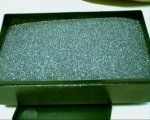tearing is possible, however it usually stretches and deforms more easily then it tears. one of the characteristics of fine silver is it's ability to deform easily without fract however it deforms much easier then it tears. In short, you can bend, draw, mash, or stretch silver MUCH easier then say aluminum foil. Different metals, different working properties. Ideally the way I would try if someone wished to, would be to push the module into the center of a small sheet of silver foil, kind of like poking your finger into the center, so it covers the end and wraps around the sides, then poke it into the heatsink, forcing the module into place, then cut any silver off the front with an exact o knife. The silver SHOULD deform enough to fill any gap, with minor, if any, tearing, although it would depend on the gap in question. if the gap is less then 30% of the thickness of the silver foil, then it probably will tear. this is a rough estimate, not a promise, as there are different things that can impact. most notably: any sharp surface, including dust, can and will cut the foil, starting a tear, and if the foil is already work hardened, and was not annealed. While copper does conduct heat well, it is also MUCH less ductile and malleable than silver. and aluminum is quite brittle by comparison.
If you have worked with lead foil, and felt how soft it is and easily deformed, silver is MORE ductile AND malleable then lead. i.e. softer, and easier to make work in this regard. It has been a while since I have worked with silver foil, and the company I last bought some from has discontinued carrying it. so I have not bought from the company I linked to, I simply googled it and posted the link. I would advise before buying it, calling or e-mailing them and asking if the silver foil is annealed. A common term for the annealed silver is "dead soft" simply verify that it is before purchasing it.
Ductility - Wikipedia, the free encyclopedia
StridAst





